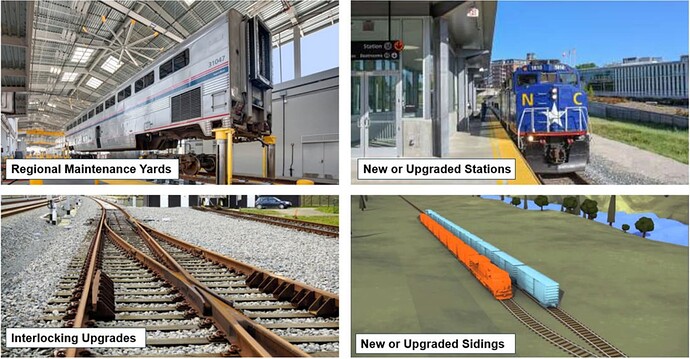Cross-posting from the RTP thread:
…also, the slide deck linked to something we haven’t really seen since the commuter/regional rail study shut down: concrete steps for how to make regional heavy rail happen using existing tracks in the Triangle.
The idea, now, is to build “an incremental rail expansion strategy” so that rail infrastructure gets added over time as our region keeps growing and getting denser - so that, when we’re ready for Attempt 4™, it would actually cost a future train operator less money to make it happen. This strategy seems to consist of four steps (there’s five of them in the slides, but the fifth is more of a project management thing):
1. Evaluate concepts for intercity rail service
…and by “intercity”, I think they mean “regional”. The slide listed these six segments as ones that they could consider:
The colors are different service patterns:
- Mebane - Clayton: 3 round trips per day
- Apex - Wake Forest: 3 round trips per day on its own
- Durham - Raleigh: 3 round trips per day on its own
- Lillington - Raleigh: 3 round trips per day
- Durham - Carrboro: 3 round trips per day
- Sanford - Franklinton: this is on the map but I don’t think this is included in the math for number of round trips
…and the way that these routes overlap mean that certain segments get more round trips; I think that’s what the number of round trips in the black-and-white boxes mean. Specifically:
- Durham - Cary: 6 total round trips per day (3 from Raleigh-Durham + 3 from Mebane-Clayton)
- Cary - Raleigh: 9 total round trips per day (6 from above + 3 from Apex-WF)
2. Figure out what capital projects each service concept would need
These are things like…
3. For each capital project, predict how attractive they are for state and federal investments
The slide suggests prioritizing in this order:
Why aren’t stations listed in any of those six steps? That’s because we need to…
4. Produce a decision tree for making investments - strategically
There’s different, easier ways to pay for the above - and TWTPO seems to think it’s easier to use those “lamer” projects as a lay up so that the flashy, politically riskier station projects can become a slam dunk. ![]()

